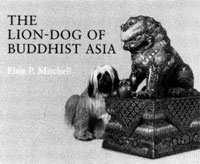The Lion-Dog of Buddhist Asia
By Elsie P. Mitchell Fugaisha: New York, 1991.
191 pp. 57 plates. $50 (hardcover) / $27.50 (paperback).
Distributor: Charles E. Tuttle Company

Anyone born in the Year of the Dog (1910, 1922, 1934, 1946, 1958, 1970, or 1982) will want to own a copy of Elsie Mitchell’s The Lion-Dog of Buddhist Asia, a book that could only have been written by a dog lover whose affections extend to canines of all kinds, both real and mythical—or anything in between. The author prefaces this guide to the canine pantheon of the East by noting it was inspired by a “real” dog, a small Shih Tzu named Sing Tow who somehow managed to survive World War II. Attended by a Vietnamese manservant, Sing Tow spent the war on a love seat in a faded Parisian drawing room, a chamber entered by a doorway curtained with drapes sewn from the King of Siam’s silk trousers. Through this portal a salon of human friends came and went, spending afternoons perusing Oriental objets d’art or, as more befitted the times, pondering the meaning of samsara.
The name Sing Tow, Ms. Mitchell informs us, means “lion” in Thai, an unlikely epithet for a drawing-room companion. The linguistic connection between dogs and lions extends also to China: the unsuspecting American housewife who spends $150 for a Shih Tzu puppy at the corner pet shop scarcely realizes she has actually just bought a shih-tzu, or “lion,” as she would have known could she speak Chinese.
Whence this association between lions and dogs in Asia? Ms. Mitchell traces the origins of this relationship to the intermarriage of artistic depictions of the Indian lion (the legendary “dog-lion” in her terms) with the physical form of Chinese pet lion-dogs, such as Pekingese. Indian art motifs were introduced to China along with Buddhism when the religion was transmitted to the Middle Kingdom in the early centuries of the common era. Since Chinese artists had never seen real lions but relied entirely upon imported images as visual references, they cannot be blamed for producing Buddhist lions that more closely resemble Chinese lap dogs (the nearest four-legged equivalent) than they do the king of beasts.

The fifty-seven color plates of The Lion-Dog of Buddhist Asia illustrate how the imagery of mythic lions and pet dogs in Asian art spontaneously interbred to produce a fabulous litter of hybrid creatures of all shapes and sizes: minute Japanese netsuke carvings of dogs emerging from eggs, Chinese temple guardian dogs of sculpted stone, and celestial turquoise Tibetan snow lions, to name but a few examples. The lion-dog bestiary includes the legendary tapirlike Japanese baku, whose Chinese counterpart was thought to eat anything, including copper and iron. Jungians will note that the snouted baku even ate bad dreams: when experiencing a nightmare, one had but to cry “Eat it, baku!” and the creature would promptly devour the offending apparition.
Other Japanese varieties of mythical lion-dogs, such as the shishi, were more closely associated with Buddhist folk beliefs and didactic religious themes. As depicted in art, these liondogs were often metaphors for spiritual strength and perseverance. One nineteenth-century woodblock print of a female shishi and her cub shows the mother lion-dog peering over a steep precipice to watch her baby clamber up the 90-degree slope; she has just deliberately pushed it over the edge to test its endurance and ability to climb back up so as to serve as a lion-dog of the Buddha. The artist thoughtlessly left the baby scrambling in mid-air, just short of its goal.
The Lion-Dog of Buddhist Asia is a collection of historical and mythical anecdotes. Derived from a wide variety of source materials, the book initiates the general reader—and potential Shih Tzu buyers—into the iconography and lore of a diverse four-legged menagerie of Asian art. Art historians and scholars of Buddhist folklore will also find here an introduction to an entire family of visual motifs that awaits interpretation.